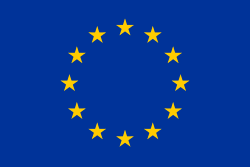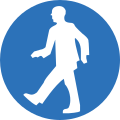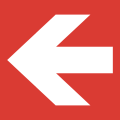Top Qs
Timeline
Chat
Perspective
Directive 92/58/EEC
European Directive harmonizing safety signs From Wikipedia, the free encyclopedia
Remove ads
The Directive 92/58/EEC specifies the minimum requirements for safety signs within the European Union.[1] It superseded the Directive 77/576/EEC.[1] While not being replaced by the standard ISO 7010, both signage systems can be used.[2] This directive does not apply to signage used for controlling roadway, railway, waterway or air transportation.[1]

Remove ads
Structure
Directive 92/58/EEC consists of 3 sections, 12 articles and 9 annexes.[1] Section one simply defines the function of the directive, as well as provide definitions. Section 2 specifies that employers are required to post safety/health signs, whenever a hazard can't be eliminated.[1] It also provides guidance to member states regarding adoption of the directive in their laws and the implementation of the law. Signs already in use had to be brought up to Directive 92/58/EEC standards within 18 months after 24 June 1994. Signs posted on or after 24 June 1994 were required to comply with the directive when posted.[1] Section 3 contained the effective date for the directive, repealed the older Directive 77/576, and reporting obligations of member states to the European Commission.[1]
Remove ads
Annexes
Summarize
Perspective
The nine annexes of the directive layout the actual designs and requirements of signs regulated by the directive.[1]
Annex I
Annex I, General Minimum Requirements Concerning Safety And/Or Health Signs At Work, lays out the types of signs, the colors used on signs, and the implementation/installation of signs.[1]
Annex II (Signboards)
Annex II, Minimum General Requirements Concerning Signboards, spells out the designs of symbols used in the directive. While specific symbol designs are provided, pictograms are permitted to vary so long as the variation in design does not reduce the symbol's effectiveness at conveying its meaning.[1]
The directive contains five categories of signs, as shown below:[1]
Prohibitory signs
- No smoking
- Smoking and naked flames forbidden
- No access for pedestrians
- Do not extinguish with water
- Not drinkable
- No access for unauthorized persons
- No access for industrial trucks
- Do not touch
Warning signs
- Flammable material or high temperature
- Explosive material
- Toxic material
- Corrosive material
- Radioactive material
- Overhead load
- Industrial vehicles
- Danger: electricity
- General danger
- Laser beam
- Oxidant material
- Non-ionizing radiation
- Strong magnetic field
- Obstacles
- Drop
- Biological risk
- Low temperature
- Harmful or irritant material
(Withdrawn 2014)[3]
Mandatory signs
- Eye protection must be worn
- Safety helmet must be worn
- Ear protection must be worn
- Respiratory equipment must be worn
- Safety boots must be worn
- Safety gloves must be worn
- Safety overalls must be worn
- Face protection must be worn
- Safety harness must be worn
- Pedestrians must use this route
- General mandatory sign (to be accompanied where necessary by another sign)
Emergency escape or first-aid signs
- Emergency exit/escape route
- Emergency exit/escape route
- Emergency exit/escape route
- Emergency exit/escape route
- Emergency exit/escape route
- This way (supplementary information sign)
- This way (supplementary information sign)
- This way (supplementary information sign)
- This way (supplementary information sign)
- First-aid post
- Stretcher
- Safety shower
- Eyewash
- Emergency telephone for first-aid or escape
Fire-fighting signs
- Fire hose
- Ladder
- Fire extinguisher
- Emergency fire telephone
- This way (supplementary information sign)
- This way (supplementary information sign)
- This way (supplementary information sign)
- This way (supplementary information sign)
Annex III
Annex III, Minimum Requirements Governing Signs on Containers and Pipes', lays out specific requirements for labeling of piping systems and storage containers containing dangerous substances defined by Directives 67/548 and 88/379.
Annex IV
Annex IV, Minimum Requirements for the identification and location of fire-fighting equipment, is specific to fire-fighting equipment, specifying that red should be used to mark the equipment and its storage location, to supplement the fire-fighting signage provided in Annex III.
Annex V

Annex V, Minimum Requirements Governing Signs Used For Obstacles and Dangerous Locations, and Marking Traffic Routes, lays out the use of colored stripes for marking obstacles and identifying of traffic routes in work places.[1]
Annex VI
Annex VI, Minimum Requirements for Illuminated Signs, sets standards for the use of illuminated signage, the incorporation of colors and pictograms, as defined in Annex I and II and usage with acoustic signals.[1]
Annex VII
Annex VII, Minimum requirements for Acoustic Signs, sets requirements for sound signals, such as horns, sirens, alarm bells.[1]
Annex VIII
Annex VIII, Minimum requirements for Verbal Communication, sets requirements for communications using words, and defines specific code words.[1]
Annex IX
Annex IX, Minimum Requirements for Hand Signals, describes specific hand signals and the requirements of a "signalman", the person giving the hand signs.[1]
Remove ads
Implementation in member states
Summarize
Perspective
European member states adopted the directive in the following legal acts in their nation.
- Austria: Kennzeichnungsverordnung[4]
- Belgium: Arrêté royal du 17 juin 1997 [5]
- Bulgaria: РД-07/8 от 20 декември 2008 г.[6]
- Croatia: NN 29/2005 [7]
- Cyprus: Σημανσης Ασφαλειας Και Υγειας Στους Χωρους Εργασιας 2012 [8]
- Czechia: Č 11/2002 Sb.[9] (Replaced by Č 375/2017 Sb.[10])
- Denmark: BEK nr 1246 af 11/12/2009 [11]
- Estonia: Vastu võetud 30.11.1999 nr 75 Ohumärguannete kasutamise nõuded töökohas[12]
- Finland: Nr. 687/2015 [13]
- France: Arrêté du 4 novembre 1993 relatif à la signalisation de sécurité et de santé au travail[14]
- Germany: Arbeitsstättenverordnung,[15] specified by Technische Regel für Arbeitsstätten ASR A1.3[16]
- Greece: Π.Δ. 105/1995 [17]
- Hungary: 2/1998. (I. 16.) MüM rendelet a munkahelyen alkalmazandó biztonsági és egészségvédelmi jelzésekről [18]
- Ireland: Safety, Health and Welfare At Work (Signs) Regulations, 1995[19]
- Italy: Decreto Legislativo 14 agosto 1996, n. 493,[20] replaced by Decreto Legislativo 9 aprile 2008, n. 81[21]
- Latvia: Rīgā 2002.gada 3.septembrī prot. Nr.37 17.§ [22]
- Lithuania: 1999 m. lapkričio 24 d. Nr. 95 Vilnius [23]
- Malta: S.L.424.16 2002 [24]
- Netherlands: Arbeidsomstandighedenregeling [25]
- Portugal: Portaria n.º 1456-A 1995, de 11 de dezembro [26]
- Romania: Hotararea de Guvern 971 din 2006 [27]
- Slovakia:Z.z. 387/2006
- Slovenia:Uradni list RS, št. 34/10
- Spain: Real Decreto n° 485/97 [28]
- Sweden: AFS 2008-13 (Replaced by AFS 2020-1)
Similar implementations in non-member states
- Iceland: Stjtíð. B, nr. 707/1995
- India: IS 9457 2005 (A copy of the preceding standard 77/576/EEC was also active in India as IS 9457 1980)
- Northern Cyprus: 35/2008 Sayılı Yasa
- Finland: Forskrift 6. oktober 1994 nr. 972
- Ukraine: Кабінету Міністрів України постанова від 25 листопада 2009 р. N 1262 Київ [29]
- Turkey: Resmi Gazete Tarihi: 25325/2003
- United Kingdom: The Health and Safety (Safety Signs and Signals) Regulations 1996[30] (Passed when an EU member, no longer a member.) The Law and Sign Standard is still in force and in-accordance with the EU (2024)
Remove ads
See also
References
External links
Wikiwand - on
Seamless Wikipedia browsing. On steroids.
Remove ads








































































